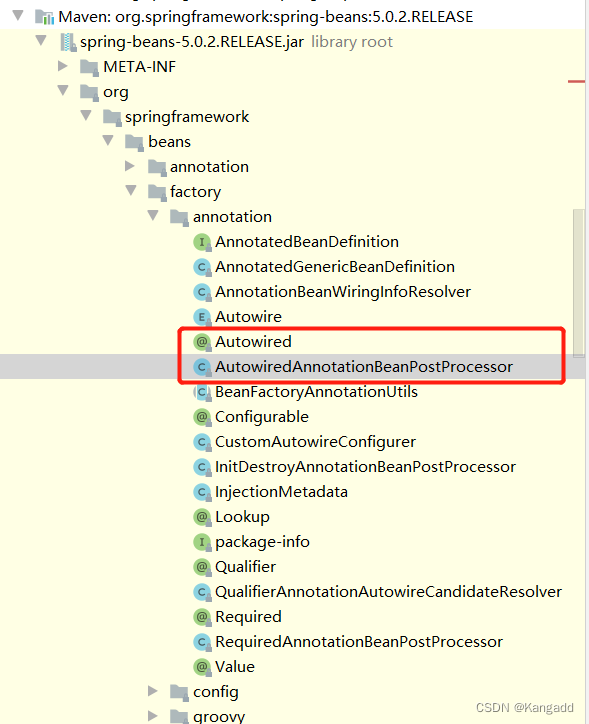@Autowired注解是Spring框架中最常用的注解之一,它可以按照类型自动注入我们所需要的对象,观察源码
import java.lang.annotation.Documented;
import java.lang.annotation.ElementType;
import java.lang.annotation.Retention;
import java.lang.annotation.RetentionPolicy;
import java.lang.annotation.Target;
@Target({ElementType.CONSTRUCTOR, ElementType.METHOD, ElementType.PARAMETER, ElementType.FIELD, ElementType.ANNOTATION_TYPE})
@Retention(RetentionPolicy.RUNTIME)
@Documented
public @interface Autowired {
boolean required() default true;
}我们可以看到@Autowired注解可以应用在构造方法,普通方法,参数,字段,以及注解这五种类型的地方,它的保留策略是在运行时,其中直接应用于字段是我们使用的最多的一种方式,那么Spring框架是如何做到使用@Autowired注解完成自动注入?
在Spring中,@Autowired注解位于org.springframework.beans.factory.annotation包下面,我们发现在这个包下面还有一个关键的类:AutowiredAnnotationBeanPostProcessor

经过分析,不难发现Spring对@Autowired注解的实现逻辑位于类:AutowiredAnnotationBeanPostProcessor之中,其中的核心处理代码如下:
private InjectionMetadata buildAutowiringMetadata(final Class<?> clazz) {
LinkedList<InjectionMetadata.InjectedElement> elements = new LinkedList<>();
Class<?> targetClass = clazz;//需要处理的目标类
do {
final LinkedList<InjectionMetadata.InjectedElement> currElements = new LinkedList<>();
/*通过反射获取该类所有的字段,并遍历每一个字段,并通过方法findAutowiredAnnotation遍历每一个字段的所用注解,并如果用autowired修饰了,则返回auotowired相关属性*/
ReflectionUtils.doWithLocalFields(targetClass, field -> {
AnnotationAttributes ann = findAutowiredAnnotation(field);
if (ann != null) {//校验autowired注解是否用在了static方法上
if (Modifier.isStatic(field.getModifiers())) {
if (logger.isWarnEnabled()) {
logger.warn("Autowired annotation is not supported on static fields: " + field);
}
return;
}//判断是否指定了required
boolean required = determineRequiredStatus(ann);
currElements.add(new AutowiredFieldElement(field, required));
}
});
//和上面一样的逻辑,但是是通过反射处理类的method
ReflectionUtils.doWithLocalMethods(targetClass, method -> {
Method bridgedMethod = BridgeMethodResolver.findBridgedMethod(method);
if (!BridgeMethodResolver.isVisibilityBridgeMethodPair(method, bridgedMethod)) {
return;
}
AnnotationAttributes ann = findAutowiredAnnotation(bridgedMethod);
if (ann != null && method.equals(ClassUtils.getMostSpecificMethod(method, clazz))) {
if (Modifier.isStatic(method.getModifiers())) {
if (logger.isWarnEnabled()) {
logger.warn("Autowired annotation is not supported on static methods: " + method);
}
return;
}
if (method.getParameterCount() == 0) {
if (logger.isWarnEnabled()) {
logger.warn("Autowired annotation should only be used on methods with parameters: " +
method);
}
}
boolean required = determineRequiredStatus(ann);
PropertyDescriptor pd = BeanUtils.findPropertyForMethod(bridgedMethod, clazz);
currElements.add(new AutowiredMethodElement(method, required, pd));
}
});
//用@Autowired修饰的注解可能不止一个,因此都加在currElements这个容器里面,一起处理
elements.addAll(0, currElements);
targetClass = targetClass.getSuperclass();
}
while (targetClass != null && targetClass != Object.class);
return new InjectionMetadata(clazz, elements);
}最后这个方法返回的就是包含所有带有@Autowired注解修饰的一个InjectionMetadata集合。这个类由两部分组成:
public InjectionMetadata(Class<?> targetClass, Collection<InjectedElement> elements) {
this.targetClass = targetClass;
this.injectedElements = elements;
}一是我们处理的目标类,二就是上述方法获取到的所以elements集合。
有了目标类,与所有需要注入的元素集合之后,我们就可以实现@Autowired的依赖注入逻辑了,实现的方法如下:
@Override
public PropertyValues postProcessPropertyValues(
PropertyValues pvs, PropertyDescriptor[] pds, Object bean, String beanName) throws BeanCreationException {
InjectionMetadata metadata = findAutowiringMetadata(beanName, bean.getClass(), pvs);
try {
metadata.inject(bean, beanName, pvs);
}
catch (BeanCreationException ex) {
throw ex;
}
catch (Throwable ex) {
throw new BeanCreationException(beanName, "Injection of autowired dependencies failed", ex);
}
return pvs;
}它调用的方法是InjectionMetadata中定义的inject方法,如下:
public void inject(Object target, @Nullable String beanName, @Nullable PropertyValues pvs) throws Throwable {
Collection<InjectedElement> checkedElements = this.checkedElements;
Collection<InjectedElement> elementsToIterate =
(checkedElements != null ? checkedElements : this.injectedElements);
if (!elementsToIterate.isEmpty()) {
for (InjectedElement element : elementsToIterate) {
if (logger.isTraceEnabled()) {
logger.trace("Processing injected element of bean '" + beanName + "': " + element);
}
element.inject(target, beanName, pvs);
}
}
}其逻辑就是遍历,然后调用inject方法,inject方法其实现逻辑如下:
/**
* Either this or {@link #getResourceToInject} needs to be overridden.
*/
protected void inject(Object target, @Nullable String requestingBeanName, @Nullable PropertyValues pvs)
throws Throwable {
if (this.isField) {
Field field = (Field) this.member;
ReflectionUtils.makeAccessible(field);
field.set(target, getResourceToInject(target, requestingBeanName));
}
else {
if (checkPropertySkipping(pvs)) {
return;
}
try {
Method method = (Method) this.member;
ReflectionUtils.makeAccessible(method);
method.invoke(target, getResourceToInject(target, requestingBeanName));
}
catch (InvocationTargetException ex) {
throw ex.getTargetException();
}
}
}在这里的代码当中我们也可以看到,是inject也使用了反射技术并且依然是分成字段和方法去处理的。
总结起来一句话:使用@Autowired注入的bean对于目标类来说,从代码结构上来讲也就是一个普通的成员变量,@Autowired和spring一起工作,通过反射为这个成员变量赋值,也就是将其赋为期望的类实例。





















 6416
6416











 被折叠的 条评论
为什么被折叠?
被折叠的 条评论
为什么被折叠?








